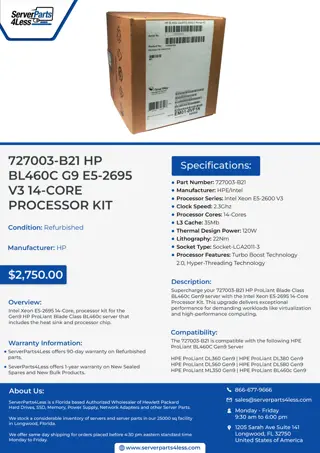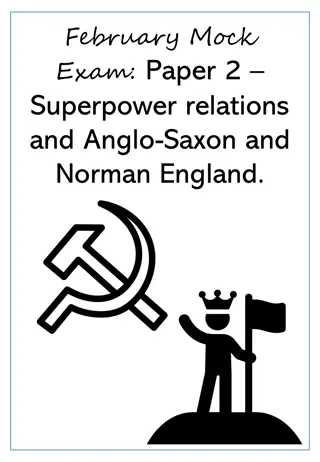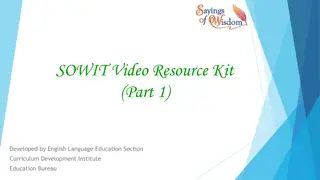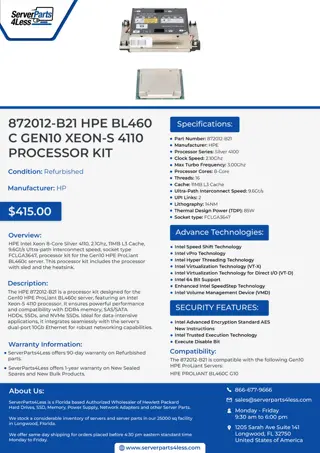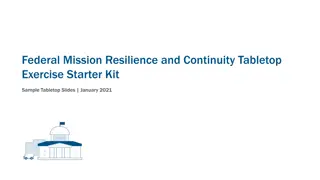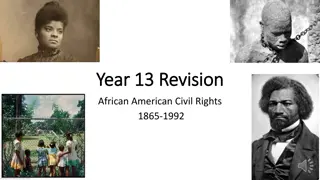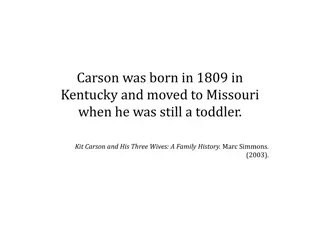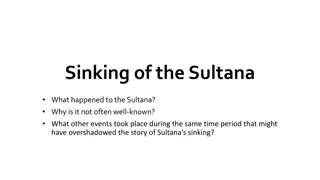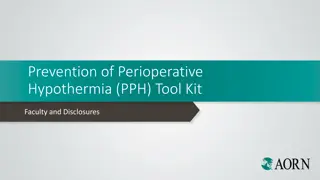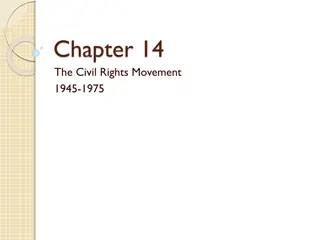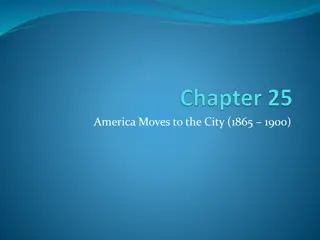America's Evolution into a Superpower: 1865-1975 Revision Kit
Explore the comprehensive revision kit for America's transformation into a superpower from 1865 to 1975. Includes grids, mind maps, and insights on key political, social, economic, and foreign policy developments. Enhance your understanding of crucial events and themes shaping American history during this period.
Download Presentation

Please find below an Image/Link to download the presentation.
The content on the website is provided AS IS for your information and personal use only. It may not be sold, licensed, or shared on other websites without obtaining consent from the author. Download presentation by click this link. If you encounter any issues during the download, it is possible that the publisher has removed the file from their server.
E N D
Presentation Transcript
America: making of a Superpower 1865-1975 This is a revision kit to help you. Feel free to save it, amend it and make it your own. Use some of it or all of it. It is a collection of resources to help you approach your revision in a practical and focused way. Each resource is prefaced with advice on how you might use it in your revision.
Revision Suggestion The Overview Grid Use the overview grid that follows to add key points/examples for each period/topic studied to help you chart the bigger themes such as Political, Social, economic, Foreign Policy and Race Relations over the whole course. NB. Amend the grid to suit you! You might want to amalgamate social and race relations for example. Or you may want to do foreign policy as a completely separate table.
Topic/Period Key Political Developments Key Social Developments Key Economic Developments Key Foreign Policy Events Civil Rights 13th, 14th, 15thAmendments 10% plan v Wade Davis Bill Radical Reconstruction DemocratRedeemers Hayes Compromise 1877 Republican Hegmenoy 13th, 14th, 15thAmendments Freedman s Bureau Share cropping North v South divide 13th, 14th, 15thAmendments Black Codes 1866 and 1875 CR Acts Rise of Jim Crow KKK and the enforcement acts North v South divide Southern recovery 1873 Depression Monroe Doctrineongoing Westward Expansion and Manifest destiny ongoing Emancipation partly motivated to stop Britain supporting South Reconstruction Gilded Age Westward Expansion Populism and Progressivism WWI Foreign Policy 1865-1920
1920s Depression and New Deal Foreign Policy 1920-1945 WWII
Truman Ike JFK LBJ Nixon Foreign Policy 1945-1975
Revision Suggestion Mind Map Use the following the proforma to brainstorm different periods/theme/questions. 1. Place the period/theme/question in the centre. 2. Around it identify different key points/factors to discuss. 3. Around the outer rings add key examples to support and challenge the point/factor. NB. Add colour, pictures and amend diagram to suit you!
Revision Suggestion Presidential Overviews Use the grid that follows to summarise the key events/examples linked to specific Presidents. Add the maximum of 5-6 key events/examples to each box so you are forced to select only the most useful details. Try to include both positive and negative examples. NB. You won t necessarily need to fill in every box for every President.
Politics and Government Foreign Policy Insert President Society Economy
Revision Suggestion Presidential Overviews Use the grid that follows to summarise the key events/examples linked to specific Presidents. Add the maximum of 5-6 key events/examples to each box so you are forced to select only the most useful details. Try to include both positive and negative examples. NB. You won t necessarily need to fill in every box for every President.
Case Study Theme/Event = Case Study Theme/Event = Case Study Theme/Event = Case Study Theme/Event =
Revision Suggestion Question Plan (Essay style) Use the following grid to plan responses to essay questions. 1. Place the question in the centre. 2. Brainstorm 3-4 big points/factors to cover (the main paragraphs of your essay) 3. Add in key examples to support and challenge your point (you can label these with + and signs to help show your analytical thinking).
Factor/Big point 1 Factor/Big point 2 Insert Question Factor Big Point 3 Factor/Big Point 4 or Conclusion
Revision Suggestion Question Plan (Extract) Use the following grid to plan responses to essay questions. 1. Identify the Argument in each Extract. 2. Select 1-2 quotes from each extra. 3. Link evidence that to support and challenge the points 4. Reach a judgement on each extracts worth.
Extract 1 Extract 2 Extract 3 Argument Summary Key Quote 1 Evidence to support/challenge Key Quote 1 Evidence to support/challenge Final Judgment
Revision suggestion Practice analytical paragraphs 1. 2. 3. Choose a question and identify 2-3 big points/factors Choose one factor to analyse and write a paragraph about (maybe redo one from a previous essay?) Write a topic sentence with an analytical focus - What words can you use to convey the strength of your agreement or disagreement with the importance of the point/factor? Fully/Largely/Broadly/To some extent/Partially/Mainly disagree 4. Now choose up to 6 examples that both support and challenge the point. 5. Now consider Where your However should fall - How should I deploy my examples to support my point? Plan them out as shown below showing different views is analysis! Reaching a judgement about how far/which view is correct is evaluation. 1/2 3 4/5 6. Write up your analysis 7. Add a summative sentence to aum up your analysis! 4/5 3 1/2
Practice Questions Essay Style (25 marks Approx. 45-50mins) Reconstruction had successfully reunited the USA by 1877 . Assess the validity of this view. Reconstruction had failed by 1877 due to opposition . Assess the validity of this view. The main impact of Reconstruction for African-Americans was the introduction of Jim Crow Laws . Assess the validity of this view. The greatest threat to the position of African-Americans in the USA 1865-1877 was formal segregation . Assess the validity of this view. The main reason for the growth of the US economy 1865-1877 was improving transport . Assess the validity of this view. Between 1865 and 1890 the USA was a deeply divided nation . Assess the validity of this view. The main reason for Westward Expansion 1865-1890 was the belief in Manifest Destiny . Assess the validity of this view. The main reason for the growth of the US economy 1865-1890 was the Railroad . Assess the validity of this view. The Gilded Age a period of Political Corruption and economic greed The main reason for the growth of the US economy 1865-1877 was the railroad . Assess the validity of this view. Big business not big government grew the economy 1890-1918 Assess the validity of this view. To what extent was the support of big business the main reason for the Republican hegemony 1865-1912? To what extent was the Regulation of Big business the main impact of the Progressive Era? To what extent was Wilson the most progressive President in the period 1890-1920? Internal divisions were the main threat to the Republican Party s control in the period 1865-1912 Assess the validity of this view. Between 1865 and 1914 the main effect of increased immigration was increased nativisim and intolerance . Assess the validity of this view. America made little social progress 1865-1914 . Assess the validity of this view. Between 1890 and 1914 US society changed dramatically Assess the validity of this view. US foreign Policy was driven by the need for new markets in the period 1865-1914 . Assess the validity of this view. To what extent did WWI create positive and lasting change in the USA?
Practice Questions Essay Style (25 marks Approx. 45-50mins) By 1918 the USA was a more harmonious nation than it had been in 1865 Assess the validity of this view. To what extent was the car industry the driving force behind the boom of the 1920s? The USA was an intolerant society that progressed little in the 1920s Assess the validity of this view. To what extent was prosperity in the 1920s fragile? To what extent were Republican Policies to blame for the Great Depression? Presidential Policies had little impact on the economy and society 1920-1945 Assess the validity of this view. The New Deal Failed Assess the validity of this view. WWII, not the New Deal, was responsible for economic recovery between 1932 and 1945 Assess the validity of this view. Isolationism drove US foreign policy 1919-1941 Assess the validity of this view. The USA became involved in WWII for remarkably similar reasons to WWI Assess the validity of this view. Civil Rights made little progress between 1917 and 1945 Assess the validity of this view. From 1932-1960 the Republican Party was hopelessly out of touch with the American People Assess the validity of this view. US Foreign Policy was confused and contradictory 1920-1975 Assess the validity of this view. Between 1945 and 1975 the democratic party s greatest weakness was it internal divisions Assess the validity of this view. Between 1945 and 1975 was deeply divided Assess the validity of this view. Between 1945 and 1975 Presidential Action was the main reason for Civil Rights advances Assess the validity of this view. Between 1945 and 1975 government spending drove US prosperity Assess the validity of this view. Between 1945 and 1975 Containment was costly and unsuccessful Assess the validity of this view. Between 1945 and 1975 the USA experienced a social revolution Assess the validity of this view. Between 1945 and 1975 fear of communism was the greatest reason for internal divisions in the USA Assess the validity of this view.
Practice Questions Extract Style (30 marks approx. 50-60 mins inc. planning) These will usually ask you the following question Using your understanding of the historical context assess how convincing the arguments in these three extracts are in relation to They often focus on views of a particular President (chosen from any!) but can also be about views of specific periods (i.e. the Reconstruction, the Gilded Age, The 1920s, the New Deal era) or about major events (i.e. WWII or the depression). NB. It could be on anything not just the examples given here so revise widely! You can obtain a number of extract questions to practice from your teacher and the history department website.









